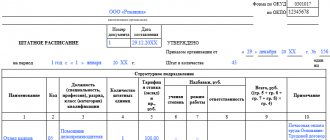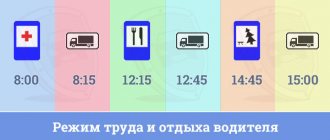It is important for the driver to observe the work and rest schedule - the law prohibits driving a vehicle in a tired state (clause 2.7 of the Russian Traffic Regulations). Overfatigue and inattention often lead to accidents on the roads - according to statistics, more than half of all accidents are associated with driver fatigue.
The article said:
- What schedule can a driver work on?
- Driver working time tracking: how many hours a day can he work?
- What is included in a driver's working time?
- What types of driver rest are there?
- What is the difference between the work and rest schedules of bus, truck and taxi drivers?
- Who controls the driver’s work and rest schedule and how?
- Fines for violations of the work and rest regime of drivers
- How to pay a fine for violating the RTO
What schedule can a driver work on?
The driver’s work and rest regime must be recorded in the Internal Labor Regulations (ILR) of the organization in which he works, and specified in the employment contract (Article 57 of the Labor Code of the Russian Federation). The duration of working hours, the number of breaks and days off are regulated by the driver’s schedule. They come in three types:
- Removable. The driver goes to work on his shift - day, evening or night based on the schedule. The schedule is drawn up monthly by the employer and communicated to the employee no later than a month before it comes into effect.
- Explosive. A driver's work shift consists of several periods with breaks between them, because the intensity of transportation is uneven throughout the day. This helps avoid overtime. The total duration of working periods fits into the norms of the Labor Code of the Russian Federation. The first break during a discontinuous schedule may occur no earlier than 4 hours from the start of the shift.
- Irregular. The driver is called to work as needed, often outside the established working hours.
To whom is it provided?
Working relationships between the parties can arise for different reasons and types of agreements.
Thus, if the contract was concluded in the civil law regime, the work and rest regime is determined by the employee and his customer without defining a specific period for the performance of the work.
However, if there is permanent employment, secured by the terms of the same employment contract, compliance with the norms of providing daily rest between shifts is mandatory within the framework of the Labor Code of the Russian Federation, which regulates the second type of legal relationship.
In what cases is it permissible to recall an employee from vacation? You will find the order for granting leave to the General Director here.
Driver working time tracking
The features and duration of working hours for drivers are prescribed in Order of the Ministry of Transport No. 424 “On approval of the Peculiarities of the Working Time and Rest Time for Car Drivers.” Depending on the schedule and nature of the work, the organization uses one of two methods for recording the working time of the driver employee.
- Daily. The maximum working time under a normal schedule does not exceed 40 hours per week and 9 hours per day.
- Summarized. During the week, the driver can work more than normal. The main thing is that the total time worked does not exceed the monthly norm. Or a three-month standard - in agreement with the trade union
With the summarized accounting method, the working day can be extended to 10 hours, but not more than 2 times a week. In exceptional cases, working hours can be increased to 12 hours for drivers employed in:
- passenger transportation in the city or suburbs,
- transportation over long distances to get to a vacation spot
- transportation for healthcare institutions and other services.
Overtime work must not exceed 4 hours for two consecutive days and 120 hours per year. The total driving time for a calendar week should not exceed 56 hours, and for two consecutive weeks - 90 hours.
Break between shifts
For drivers
The duration of the work shift is regulated by the Labor Code and regulations. In accordance with them, an employee should not work more than 40 hours a week. It follows from this that the duration of one shift during a five-day shift cannot be more than 8 hours.
Some exceptions apply to drivers' working and rest conditions. The rest between shifts for this category of workers cannot be shorter than twice the previous shift. It must be taken into account that lunch breaks are necessarily included in the inter-shift break.
| Nature of work | Duration of break between shifts | Possibility of shortening the break | Compensation for layoffs |
| Cumulative accounting of working hours. City and suburban routes | No shorter than 12 hours | It is possible to reduce the break between shifts by no more than 3 hours | In this case, after the break is shortened, he must be given rest between shifts for two days. |
| Intercity transportation | No shorter than 11 hours | It is possible to reduce the break between shifts by no more than 2 hours, but not more than 3 times a week | Compensation for excess time worked is provided in an amount not less than that which the driver was deprived of |
It is allowed to break the break between shifts into several parts. The main condition is that one of its segments should not be shorter than 8 hours.
For health workers
The duration and working conditions of medical workers have certain specifics. In accordance with legislative acts, the working day of a worker in the healthcare sector cannot exceed 39 hours per week. Health workers are conventionally divided into categories, according to which the working week is set to:
- 24;
- 30;
- 33;
- 36 hours.
Accordingly, the duration of a health worker’s shift in a standard five-day week will be less than 8 hours. The break between shifts for them cannot be shorter than double the duration of the shift preceding it.
What is included in a driver's working time?
In addition to driving the vehicle, the following are taken into account when calculating the driver’s working time:
- Preparation for the flight and final work after returning to the organization. When traveling long distances and intercity transportation, the time spent working at the transit point is additionally taken into account. The composition and duration of these works are established by the employer in agreement with the organization's drivers.
- Pre- and post-trip medical examinations. Their duration is also set by the manager.
- Parking at loading and unloading points and passenger pick-up/drop-off points.
- Time for special breaks for rest from driving (special break). The driver must take a rest break from driving no later than after 4.5 hours behind the wheel. You need to rest for at least 45 minutes.
- Downtime is not the driver's fault.
- Work to eliminate faults discovered along the way, which do not require disassembling the mechanisms or towing them to a car service center.
Previously, if there were two drivers in a shift, the second driver was included in working hours during the time when he did not drive the car, but simply rode in the cab. Now it is not considered a worker, but is paid in the amount established by the collective agreement or local regulations of the employer.
What types of driver rest are there?
| Type of holiday | Duration |
| Break for rest and food during the working day | From 30 minutes to 2 hours. |
| Daily (between shifts) rest | At least 2 times longer than a work shift. In exceptional cases - at least 9 hours. |
| Weekends (weekly uninterrupted rest) | The total duration is at least 45 hours. |
| Annual leave | Minimum 28 calendar days. |
Let's look at each of them in more detail.
Breaks for rest and food
The break can range from 30 minutes to 2 hours. If a working day (shift) lasts more than 8 hours, then there can be two breaks, but their total duration should also not be less than half an hour or exceed 2 hours. Specific values are established by the employer in a local act.
Daily (between shifts) rest
The duration of such rest, if added to a break for rest and food, should be at least 2 times longer than the working day (shift) preceding it. For example, after an 8-hour work shift with a 1-hour rest break, the driver must rest for at least 15 hours before starting the next one. If the break was 2 hours, then before the next shift he must rest for at least 14 hours
When calculating working hours in total, daily rest should not be shorter than 11 hours. But you can:
- Reduce daily rest to 9 hours no more than three times during the period between the end of one weekly rest and the beginning of the next.
- Divide your vacation into several parts. The first must be at least 3 hours, the last - at least 9.
If there are several drivers in the crew, they are obliged to simultaneously and fully use the daily rest of at least 9 hours.
After Order 424 comes into force, any daily rest can be replaced with a weekly rest - weekends. Previously, it was necessary to first organize daily and then weekly rest for the driver.
Break between shift parts
With the consent of the drivers, shifts can be divided into parts. There must be breaks between parts of the shift - no later than five hours after the start of work. The total time of breaks should not exceed:
- 3 hours - for drivers who carry out regular suburban and urban transportation;
- 5 hours - for other drivers.
Weekly uninterrupted rest (weekends)
The total duration of a driver's weekly uninterrupted rest should not be less than 45 hours.
You can reduce your weekly rest to 24 hours no more than once in two calendar weeks. The driver can take the rest of the time off over the next three calendar weeks.
If there are several drivers in the crew, their weekly rest can be reduced to 24 hours each week if they rest the remaining hours over the next three weeks.
Drivers may, with their consent, be hired to work on non-working holidays if the specifics of their work are related to:
- activities, the suspension of which is impossible due to production and technical conditions;
- public service;
- repair and loading and unloading operations.
Other cases and conditions for attracting employees to work on weekends and holidays are described in Article 113 of the Labor Code of the Russian Federation.
Annual leave
Drivers, like employees of other professions, are provided with an annual basic paid leave of 28 calendar days.
For drivers with irregular working hours, additional paid leave is provided for a period of at least 3 days. Its specific duration is determined by the regulatory documents of the organization, PVTR or collective agreement.
Harmful or dangerous working conditions are also subject to additional leave of at least 7 days. Work is recognized as dangerous or harmful based on the results of a special inspection. In any case, this must be specified in the employment contract.
In addition to rest periods, drivers have special breaks.
You can continuously drive a vehicle for no more than 4.5 hours. Afterwards, the driver must take a break for at least 45 minutes. The break can be divided into several parts. In this case, the first part of the rest should last at least 15 minutes, and the last - immediately before returning to the wheel - at least 30 minutes. The continuous driving time can be exceeded by a maximum of an hour if the driver is moving to a rest area or to a final destination.
Fines for legal entities
Check
Regulatory base and duration of rest
According to the Labor Code of the Russian Federation, inter-shift rest can be defined as non-working time between shifts, during which the employee is relieved from performing his job duties. A fixed period of such rest is not defined by law, however, a number of regulations developing the provisions of articles of the Labor Code state what it should be.
Even in the decree “On working time and rest time” dated 09/24/29 of the Council of People's Commissars of the USSR, which is no longer in force, the ratio of rest and working time was established - daily rest should be no less than 2 times the duration of the work shift. Sanitary and epidemiological rules SP 2.2.2.1327-03, introduced by the Chief State Sanitary Doctor on 05/26/03 (clause 10.24 of the Rules), generally repeat this provision. The clarification concerns only lunch time - it is not included in the duration of work. During emergency work or emergency situations, rest may be less, but not less than 8 hours daily. For representatives of some professions, separate documents are adopted regulating rest between shifts.
Attention! Once a week, the employee must be given a rest period of at least 42 hours without a break (Article 110 of the Labor Code of the Russian Federation), regardless of the shift schedule.
As an example, consider Order of the Ministry of Transport No. 15 of 08/20/04, p. 3 "Rest time." The rules for inter-shift rest are reflected in detail, with a number of options and situations considered:
- The rest period from shift to shift (daily) must be at least twice the duration of working hours on the previous day or shift. The time is counted together with the lunch break.
- If working time is taken into account in total, the duration of rest daily (between shifts) as a general rule cannot be less than 12 hours.
- Under the same conditions of total accounting of work time on city routes and in the suburbs, rest can be reduced from 12 hours to 3 hours, but no more. The remoteness of the vacation spot is taken into account. After the end of the next shift, after a reduced rest period, the driver is given an increased rest period: at least 2 days. To do this, a written application from the employee is required. Such actions require the consent of a trade union or other body representing the interests of workers.
- Intercity routes have their own characteristics: total time recording assumes that between-shift rest at stops cannot last less than 11 hours. In this case, rest can also be reduced to 9 hours, but this cannot be done more than three times a week. In such a case, until the end of the next week, the driver is given compensatory, additional time, the amount equal to the shortened rest time.
- Intercity transportation without reducing rest also suggests this option: rest is divided during the day into 2-3 periods, one of which must last from 8 hours or more. The total rest here increases - no less than 12 hours.
- Long-term transportation on intercity routes requires the presence of a shift driver. The document establishes the rule: if at least two drivers worked on a route for 30 hours, each must rest for at least 8 hours without a break.
- A weekly rest of 42 hours in a row must be added to the daily (between shifts) rest - before or after it begins.
- If the driver has time to rest, he is on the road, there is no specially equipped parking on the road section; the driver has the right to continue to the nearest parking lot marked with special road signs. At the same time, he must be guided by the time standards specified in the document.
What is the difference between the work and rest schedules of bus, truck and taxi drivers?
Work and rest schedule of a taxi driver
It is not much different from the conditions described above. Taxi driver working hours include:
- medical examinations before and after the flight;
- time to receive the car and return it after the shift;
- direct driving;
- easy to wait for orders;
- eliminating breakdowns and malfunctions along the way, such as topping up the washer fluid, changing a wheel, and others, if they do not require disassembling the mechanisms or towing to a car service center;
- rest breaks from driving;
- car wash, if required.
Taxi drivers cannot have irregular working hours.
Non-working time of a taxi driver is:
- Break for meals and rest. It is usually placed mid-shift and should last between 30 minutes and 2 hours.
- Daily (between shifts) rest. The duration should be at least twice as long as a work shift.
- Weekend.
Otherwise, the types of recreation for a taxi driver are the same as those described above.
Work and rest schedule for bus and truck drivers
For drivers of buses and trucks with a maximum permissible weight of more than 3.5 tons, the work and rest regime is prescribed separately in paragraph 26 of the Traffic Regulations of the Russian Federation. They should not spend more than 9 hours a day driving. Although it is possible to increase this time to 10 hours, but no more than twice during a calendar week. At the same time, no more than 56 hours behind the wheel should accumulate in one week, and no more than 90 hours in two weeks in a row.
For drivers whose working conditions are classified as dangerous, the working day should not exceed 8 hours, and the working week should not exceed 36 hours.
Who controls the driver’s work and rest schedule and how?
The employer is obliged to monitor compliance with the work and rest schedule of drivers. All legal entities and individual entrepreneurs whose activities are related to the operation of vehicles must equip them with tachographs. Read more about which cars must have tachographs installed in our article.
A specially appointed specialist is responsible for working with tachographs in the organization. If this is not the case, then the responsibility falls on the manager. The driver must know how to use the tachograph, monitor its performance on the road and have instructions.
If the tachograph is broken, the driver can only continue driving towards the nearest service station or parking lot. The journey from the moment the device breaks down should not take more than 7 days. A list of workshops for the repair and maintenance of tachographs in the regions of Russia is on the Rosavtotrans website.
Traffic police and Rostransnadzor employees can check whether the car has a tachograph and its serviceability. There are fines for a faulty tachograph or its absence.
Fines for violations of the work and rest regime of drivers
The most common violations of the work and rest schedule of drivers are:
- the time limit for driving a vehicle has been exceeded;
- the standard working time for cumulative accounting has been exceeded;
- the driver is sent on a long trip without a replacement, especially at night;
- the manager did not draw up a work schedule for the driver.
Both the police and Rostransnadzor officials can consider cases under Article 11.23. Part 3 of Article 11.23. The Code of the Russian Federation on Administrative Offenses provides for the following fines for violating the work and rest schedule of drivers, namely for non-compliance with the norms of driving time and rest time:
- for the driver - from 1,500 to 2,000 rubles;
- for an official - from 7,000 to 10,000 rubles;
- for an individual entrepreneur - from 15,000 to 25,000 rubles;
- for a legal entity - from 20,000 to 50,000 rubles.
Check your organization's fines now
Responsibility for failure to comply with the duration of rest between shifts
In case of violation of the rest regime between workers' shifts, the punishment for the employer will be determined according to the articles of the Code of Administrative Offenses of the Russian Federation:
- Article 5.27 does not separately highlight this violation, therefore the measure of liability is established in accordance with paragraphs 1 or 2.
- Clause 2 of Article 11.23 provides for punishment directly for persons driving vehicles (drivers) if they violate the rest regime.
Punishment under Art. 5.27 is expressed in the imposition of a fine from 1,000 to 50,000 rubles, depending on the object of punishment (official, individual entrepreneur, enterprise). Art. 11.23 provides for a fine for the driver from 1000 to 3000 rubles.
According to general rules, the break between shifts should be no less than the duration of the work shift multiplied by two.
For certain categories of workers it may vary depending on working conditions. You can find more complete information on the topic in ConsultantPlus. Free trial access to the system for 2 days.
How to pay a fine for violating the driver’s work and rest schedule
It is not possible to pay a fine for violating the work and rest schedule with a 50% discount - only a deferment or installment plan of the fine is possible. Therefore, it is important to avoid violations.
You can find and pay a fine for violating the driver’s work and rest schedule on the websites of the State Traffic Safety Inspectorate, Rostransnadzor and the State Services portal. But if an organization has a large fleet of vehicles and a staff of drivers, you can find and pay all fines faster in the Online State Traffic Safety Inspectorate service: you don’t have to check each car and driver manually. The check is carried out automatically using the federal treasury database, which contains information on all fines of legal entities and individuals.
The service monitors the appearance of new car fines for the organization, notifies about them and payment deadlines in your personal account or via SMS.
Checking fines for legal entities
Find out if the organization has fines for violations of work and rest schedules
Try for free









